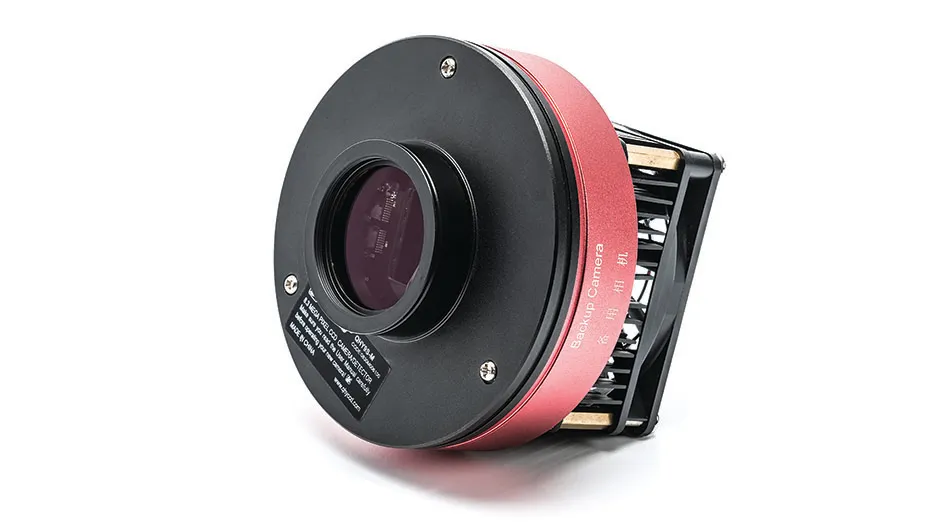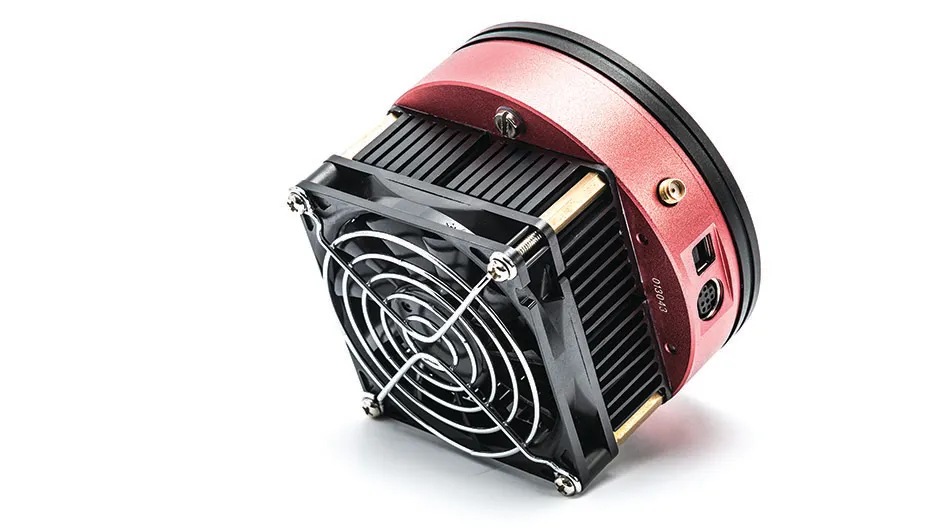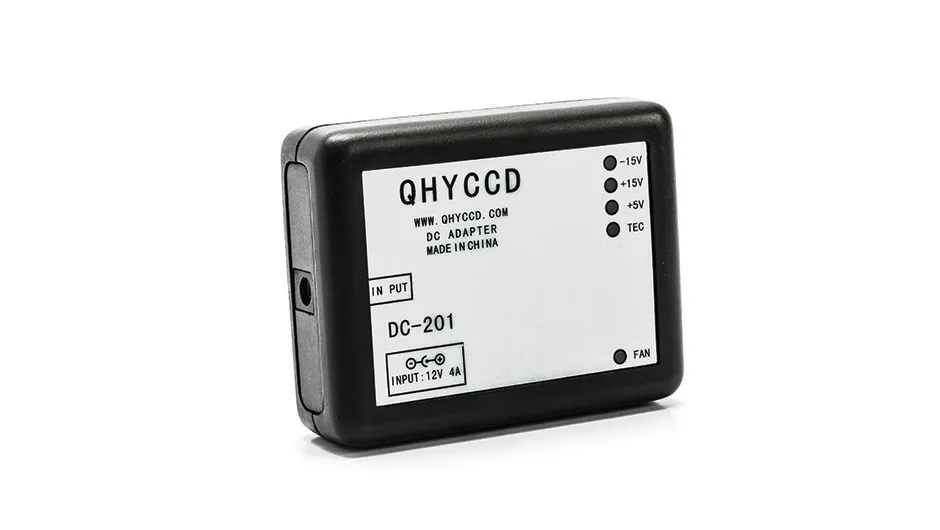Deep-sky imaging cameras come in all shapes and sizes; some have clearly had a lot of time and money spent on their aesthetics while others take a more down to Earth approach by concentrating more on function and less on form.
However, all of them are designed with an apparently simple task in mind – to capture the dim light from celestial objects many lightyears away.
The QHY9S falls into the function over form category, although it is more robust in design than unattractive, something typified by its large and clunky looking cooling fan.
The advantage of this approach to design is reflected in its relatively low price, but it still needs to perform well to appeal to imagers.
Supplied in a plain carton, the camera was well protected from damage in shipping.
Its matt black and electric red body colours were well applied, although we’ve been informed the latest retail version of the camera will be all black.
With a weight of 553g, the camera had a purposeful feel and it was simple to attach to the 2-inch filter wheel lent to us for the purpose of this review.

There is much debate in imaging circles over the filter size that can be used with the relatively large KAF-8300 sensor used in this camera, to ensure that the filter edge doesn’t cause vignetting of the image.
Vignetting results in light fall-off towards the edges of the field of view and can occur when the light cone is constricted by a physical obstruction.
For some camera designs that have a built-in filter wheel that places the filters very close to the sensor, 1.25-inch filters can be used, but the QHY9S requires 2-inch filters.
The CD supplied with the camera includes a user manual in PDF format, camera drivers, ASCOM drivers and two camera control programs, CCDCap and EZCap.
All of the drivers loaded quickly and easily onto our computer.
Although we tested the camera with both control programs, for the bulk of our review we chose to use the ASCOM driver via MaxIm DL for ease of integrating into our existing system.
Both the QHY9S and the borrowed QHY filter wheel worked seamlessly with MaxIm DL.

Cool under pressure
With the short summer nights, a tight schedule and a waxing Moon, we chose to image a HII region high overhead in Cygnus and settled on the Pelican Nebula.
This emission nebula is rich in hydrogen-alpha (Ha) emissions although somewhat weaker in Oxygen III (OIII).
We used a Baader 7nm Ha filter and an 8.5nm OIII filter to produce a false colour image by mapping Ha to red and OIII to both green and blue to produce our final RGB colour image.
The KAF-8300 sensor responds very well to cooling – we used its set point cooling feature to reach –20°C.
There were no bad columns but typical of this sensor, there were some hot pixels.
In post processing, these were simply removed by the dual actions of dithering the exposures and stacking our subframes using a method that removes the more outlier pixels.
This resulted in an image with plenty of detail and fairly realistic colours despite the use of narrowband filters.
The camera was very sensitive and once we had got used to the rather unusual ‘plopping’ noise from the mechanical sliding shutter, which served to confirm that exposures were in progress, we had an uneventful imaging session with the camera performing perfectly throughout.
There is also an anti-blooming gate, which stops vertical bleeding from fully saturated pixels so we put this to the test by imaging the Moon, which allowed us to capture short exposures yet plenty of photons.
The sensor performed well here too, capturing crisp and clear images with no sign of bleed.
We were very impressed with the performance of the camera despite its rather ordinary appearance and would recommend to both astrophotography beginners and those upgrading from a DSLR camera to their first CCD camera.

An unusual choice of sensor
The QHY9S employs an interesting choice of sensor, the monochrome KAF-8300.
This sensor neatly bridges the gap between the smaller, Sony sensors and their larger and more expensive APS-C sized sensors (the same size as found in DSLR cameras), and the even larger 35mm film equivalent sensors.
It has a total of 8.3 megapixels across its surface but its physical size allows for individual pixels of 5.4µm square to be used, producing high-resolution images without sacrificing sensitivity.
The sensor is 17.9x13.5mm, yielding a 22.5mm diagonal size, with an array of 3,336x2,496 pixels.
In a departure from more typical CCD sensors, the KAF-8300 is a full frame sensor, which means that it requires a mechanical shutter to exclude light during the image download process to avoid light smearing.
Incorporating this mechanical shutter has caused problems for some manufacturers in the past but the simple mechanism in the QHY9S works quickly and efficiently despite the rather unusual noise that it makes at the end of its travel.
Connections
With the control circuitry housed in an external control module, the connections to the camera itself are few.
A multi-pin connector provides separate power to both the camera/mechanical shutter and the cooling system.
A USB 2.0 port for connection to a computer and a control port for the optional electronic filter wheel are also present.
Set-Point Peltier Cooling
As well as the substantial cooling fan on the rear of the camera, there is a two-stage Peltier cooling system that will cool the sensor down to around 50°C below ambient temperature to reduce thermal noise.
At an ambient temperature of 19.7°C, it took 130 seconds to reach a temperature of –20°C.
Power Control Module
Unusually, the QHY9S has much of its electronic circuitry in a remote electronic power module. The thinking behind this is to keep extraneous electronic noise away from the sensor.
We found this to be a useful feature with convenient LED lights confirming supply voltage, fan activation and Peltier cooling in operation.
Moisture Control
The sensor is mounted in a fully sealed chamber with a heated cover glass to exclude dust and moisture.
This chamber has two purge ports for replacing the chamber gas if required, and an external rechargeable desiccant cylinder can be attached to one of the purge ports to extract any moisture from inside the chamber.
Camera Control Software
Two control programs (CCDCap and EZCap) are supplied with the camera and these provide uncomplicated graphical interfaces for all aspects of operation.
A simple sequencing procedure is included with each and there are plenty of options for adjusting binning, gain, temperature and offset.
Vital stats
Price: £1399.00
Weight: 553g
Supplier: Modern Astronomy
Telephone: 020 8763 9953
Website:www.modernastronomy.com
This review originally appeared in the October 2015 issue of BBC Sky at Night Magazine.
